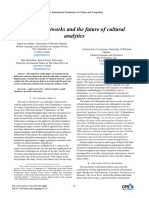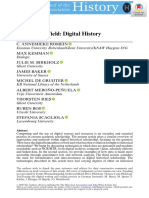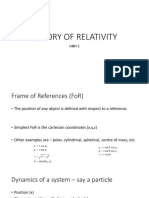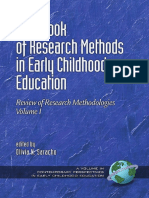0 ratings0% found this document useful (0 votes)
3 viewsDH History
DH History
Uploaded by
madaraaauchichaCopyright:
© All Rights Reserved
Available Formats
Download as PDF, TXT or read online from Scribd
DH History
DH History
Uploaded by
madaraaauchicha0 ratings0% found this document useful (0 votes)
3 views5 pagesCopyright
© © All Rights Reserved
Available Formats
PDF, TXT or read online from Scribd
Share this document
Did you find this document useful?
Is this content inappropriate?
Copyright:
© All Rights Reserved
Available Formats
Download as PDF, TXT or read online from Scribd
Download as pdf or txt
0 ratings0% found this document useful (0 votes)
3 views5 pagesDH History
DH History
Uploaded by
madaraaauchichaCopyright:
© All Rights Reserved
Available Formats
Download as PDF, TXT or read online from Scribd
Download as pdf or txt
You are on page 1of 5
History of Digital Humanities :
At this stage of evolution technology has transcend its role
of just a tool. Now that it has penetrated almost every aspect
of human life , it sure has become talk of the century with its
fair share of promoters and critiques . So now of all times ,
its important that we understand its scope leaving on DH.
DH - A by product of intersection between technology and
scholarship, which seeks to harness the power of
computational tools and methodologies to enhance research,
analysis, and interpretation of human culture. Throughout
history DH has evolved by countering perceptions of there
being a gulf between science and humanities. DH brought
out a revolution by bridging this gap. The simplistic duality
of tech and non-tech. The contradiction that anything
artificial does not or cannot hold human essence is flawed in
a sense as Paul Papadimitriou puts it “Digital behaviour is
just a replication of human behaviour.”
This essay delves into the history of Digital Humanities,
tracing its origins, key developments, and transformative
impact on the academic landscape.
Origins and Early Developments:
It all started in mid-20th century when scholars began
exploring the potential of computers in aiding traditional
humanities research.The development of computers and the
subsequent emergence of the internet paved the way for
opening up new avenues for collaboration and preservation of
cultural heritage. Computers and the Humanities, published
in 1966, was the first dedicated publication in the field of
digital humanities
The Advent of Digital Humanities:
One significant milestone in the history of Digital
Humanities was the establishment of the Center for
Electronic Texts in the Humanities (CETH)1971. It focused
on the development of computer-based tools and methods for
analyzing and interpreting textual materials. This marked
the early integration of technology into humanities
scholarship.
In 1970s, the organisation for Computer Applications and
Quantitative Methods in Archaeology (CAA) was
established. Followed by, the Association for Computers and
the Humanities (ACH) and the Association for Literary and
Linguistic Computing (ALLC) .
The Rise of Digital Tools and Infrastructure: Initially, DH
constrained itself to text analysis, text encoding,
documentation and editing of linguistic corpus. In 90s,
digital libraries, and collaborative editing took over, as
storage and processing capabilities improved starting.
Structured electronic text and multimedia archives then took
over as the field's dominant technologies. Archaeologists,
historians, literary scholars, and a wide range of humanities
academics used cutting-edge computational techniques to
revolutionize humanities scholarship in the decades that
followed. The availability of powerful computing resources
and software applications enabled scholars to undertake
large-scale digitization projects, creating digital archives
and repositories of cultural artifacts.
Furthermore, advancements in Optical Character
Recognition (OCR) technology enabled the conversion of
printed texts into machine-readable formats, making them
compliant to computational analysis. This development
opened up new possibilities for text mining, distant reading,
and the analysis of large corpora, thereby transforming the
way researchers approached textual analysis.
Collaboration and Interdisciplinarity: Digital Humanities
emphasized collaboration and interdisciplinarity, bringing
together scholars from various fields such as history,
literature, linguistics, computer science, and information
science. An openness and sharing knowledge attitude were
also promoted by digital humanities. The development of
digital platforms and archives that allowed academics to
freely share their work and communicate with others was
made possible by the widespread use of the internet.
Expanding Methodologies and Approaches:
As Digital Humanities gained traction, scholars began
exploring diverse methodologies and approaches. Geospatial
analysis, network analysis, data visualization, and data
mining techniques became integral to the field. These
computational tools enabled researchers to uncover patterns,
connections, and insights that were previously difficult to
discern using traditional methods.
The field also expanded beyond text-based analysis to
incorporate multimedia sources such as images, audio, and
video. Digital Humanities projects now encompass the
analysis and interpretation of visual and auditory
materials, fostering new ways of understanding and
experiencing cultural artifacts.
Impact and Future Directions:
Digital Humanities has had a profound impact on the
academic landscape. It has democratized access to knowledge
by digitizing and making cultural artifacts available
online, enabling broader audiences to engage with historical
materials and literary works.
Digital tools and methodologies have also enhanced the
efficiency and accuracy of research, enabling scholars to
analyze vast amounts of data and make new discoveries.
Looking ahead, the future of Digital Humanities holds
tremendous potential. Artificial Intelligence (AI), machine
learning, and natural language processing
You might also like
- Fontana, A. and J.H. Frey. From Structured Questions To Negotiated Text.Document24 pagesFontana, A. and J.H. Frey. From Structured Questions To Negotiated Text.Ósu Chan100% (1)
- Raymond B CattellDocument24 pagesRaymond B CattellAnnie Jne100% (2)
- DigitalHumanities AnIntroductionDocument10 pagesDigitalHumanities AnIntroductionallanyohan6No ratings yet
- Digital HumanitiesDocument2 pagesDigital HumanitiesSaima yasinNo ratings yet
- Digital Humanities (DH) Is An Area ofDocument19 pagesDigital Humanities (DH) Is An Area ofDawnaNo ratings yet
- Digital Humanities and Libraries: Partnership and CollaborationDocument33 pagesDigital Humanities and Libraries: Partnership and CollaborationTruong Minh HoaNo ratings yet
- A Short Guide To The Digital - Humanities: Questions & AnswersDocument16 pagesA Short Guide To The Digital - Humanities: Questions & AnswersJuliane HackerNo ratings yet
- Cyber CultureDocument6 pagesCyber CultureAfroula PapadakiNo ratings yet
- The Science of Culture Social Computing Digital Humanities and Cultural AnalyticsDocument15 pagesThe Science of Culture Social Computing Digital Humanities and Cultural Analytics7gfnyqs7q6No ratings yet
- Cultural Networks and The Future of Cultural Analytics - SuarezDocument4 pagesCultural Networks and The Future of Cultural Analytics - Suarezm.suarezvalenciaNo ratings yet
- Network For Digital Methods in The Arts and Humanities (Nedimah)Document12 pagesNetwork For Digital Methods in The Arts and Humanities (Nedimah)Patricia FariaNo ratings yet
- KirschenbaumDocument7 pagesKirschenbaumLost ScribblerNo ratings yet
- Trends Digital HumanitiesDocument5 pagesTrends Digital HumanitiesImats MulintapangNo ratings yet
- Introduction Digital HumanitiesDocument0 pagesIntroduction Digital HumanitiesCosimo AccotoNo ratings yet
- Debates in The Digital HumanitiesDocument17 pagesDebates in The Digital HumanitiesJoãoNo ratings yet
- CFP Digital Culture Society 24-01-2015 LAST REMINDER-libreDocument5 pagesCFP Digital Culture Society 24-01-2015 LAST REMINDER-libreVictoria IrisarriNo ratings yet
- Manovich CulturalAnalyticsSocial 2017Document15 pagesManovich CulturalAnalyticsSocial 2017cocoalwaysdowellNo ratings yet
- Digital Media and Contemporary Art (Lughi G)Document11 pagesDigital Media and Contemporary Art (Lughi G)flfogliatoNo ratings yet
- Ardevolgomezcruz DigitalethnographyDocument36 pagesArdevolgomezcruz Digitalethnographysalwa dahmshNo ratings yet
- Archives, Access and Artificial Intelligence: Working with Born-Digital and Digitized Archival CollectionsFrom EverandArchives, Access and Artificial Intelligence: Working with Born-Digital and Digitized Archival CollectionsLise JaillantNo ratings yet
- Romein Et Al. - State of The Field Digital HistoryDocument22 pagesRomein Et Al. - State of The Field Digital HistoryCCH - Coordenação HISTÓRIA - (EAD) UNIRIONo ratings yet
- Digital Media and Contemporary Art: Dossier InvisibiliaDocument22 pagesDigital Media and Contemporary Art: Dossier InvisibiliaVincent SitholeNo ratings yet
- Costis Dallas (2015) The Era of The Post-Repository Scholarly Practice Information and Systems in The Digital ContinuumDocument2 pagesCostis Dallas (2015) The Era of The Post-Repository Scholarly Practice Information and Systems in The Digital ContinuumCostis DallasNo ratings yet
- Philology in the Making: Analog/Digital Cultures of Scholarly Writing and ReadingFrom EverandPhilology in the Making: Analog/Digital Cultures of Scholarly Writing and ReadingPál KelemenNo ratings yet
- Digital Methods in the Humanities: Challenges, Ideas, PerspectivesFrom EverandDigital Methods in the Humanities: Challenges, Ideas, PerspectivesNo ratings yet
- Digital Anthropology - Cambridge Encyclopedia of AnthropologyDocument15 pagesDigital Anthropology - Cambridge Encyclopedia of AnthropologyFabíola GomesNo ratings yet
- Tactics of Interfacing: Encoding Affect in Art and TechnologyFrom EverandTactics of Interfacing: Encoding Affect in Art and TechnologyNo ratings yet
- Paper 12Document10 pagesPaper 12sheesheeswerNo ratings yet
- Digital Art through the Looking Glass: New strategies for archiving, collecting and preserving in digital humanitiesFrom EverandDigital Art through the Looking Glass: New strategies for archiving, collecting and preserving in digital humanitiesNo ratings yet
- Chapter 2 & 3 ProposalDocument19 pagesChapter 2 & 3 ProposalJanine LerumNo ratings yet
- Noiret - Past - Continuous - Digital - Public - History - TDocument19 pagesNoiret - Past - Continuous - Digital - Public - History - TMax MurmisNo ratings yet
- BDCC 06 00073Document19 pagesBDCC 06 00073mei chee punNo ratings yet
- The Role of Digital Humanities in Papyrology: Practices and User Needs in Papyrological ResearchDocument2 pagesThe Role of Digital Humanities in Papyrology: Practices and User Needs in Papyrological ResearchLucia VanniniNo ratings yet
- Digital Humanities and Research Methods in Religious Studies - Part8Document1 pageDigital Humanities and Research Methods in Religious Studies - Part8MansourJafariNo ratings yet
- Mela Stuff For CatDocument5 pagesMela Stuff For CatJamie AllenNo ratings yet
- The Influence of Digital Technology On The Trend of Museum MediaDocument4 pagesThe Influence of Digital Technology On The Trend of Museum MediaAnđela FilipovićNo ratings yet
- Towards A Digital Cultural StudiesDocument21 pagesTowards A Digital Cultural StudiesSphoortiN XII B 927No ratings yet
- Digital AnthropologyDocument5 pagesDigital AnthropologyLuis ValenteNo ratings yet
- Fqac012digital Humanities or Humanities in DigitalDocument13 pagesFqac012digital Humanities or Humanities in DigitalStelleNo ratings yet
- Wilson AnthropologyOnlineCommunities 2002Document20 pagesWilson AnthropologyOnlineCommunities 2002moup665No ratings yet
- ESCOBAR, Arturo - Anthropology and The FutureDocument13 pagesESCOBAR, Arturo - Anthropology and The FutureYago Quiñones TrianaNo ratings yet
- Project DescriptionDocument15 pagesProject Descriptionapi-203569369No ratings yet
- Internet Ethnography: The Past, The Present and The FutureDocument12 pagesInternet Ethnography: The Past, The Present and The FutureSudipto BasuNo ratings yet
- Ethnographic Approaches To Digital Media PDFDocument2 pagesEthnographic Approaches To Digital Media PDFDivyaNo ratings yet
- McGann, Jerome J - A New Republic of Letters - Memory and Scholarship in The Age of Digital Reproduction-Harvard University Press (2014)Document253 pagesMcGann, Jerome J - A New Republic of Letters - Memory and Scholarship in The Age of Digital Reproduction-Harvard University Press (2014)JulijanaMarkovićNo ratings yet
- Hyperdrama Dramaturgy and Post ModernityDocument12 pagesHyperdrama Dramaturgy and Post ModernityMaria Claudia TextosNo ratings yet
- 2014 Alves, Digital - Methods - and - Tools - For - Historical - ResearchDocument13 pages2014 Alves, Digital - Methods - and - Tools - For - Historical - Researchnurul audinaNo ratings yet
- Ethnography Beyond Text and Print: How The Digital Can Transform Ethnographic Expressions - Ethnography MattersDocument19 pagesEthnography Beyond Text and Print: How The Digital Can Transform Ethnographic Expressions - Ethnography Mattersnllano123No ratings yet
- Machine-Created Culture: Essays on the Archaeology of Digital Things and PlacesFrom EverandMachine-Created Culture: Essays on the Archaeology of Digital Things and PlacesNo ratings yet
- Reflection On Humanism, Citizenship, and The Digital Society (From Theory To Practice)Document62 pagesReflection On Humanism, Citizenship, and The Digital Society (From Theory To Practice)AJHSSR JournalNo ratings yet
- Digital CultureDocument212 pagesDigital CultureOscar Mauricio Ovalle Navarro100% (1)
- FAC 211 Course OutlineDocument7 pagesFAC 211 Course OutlinekanyikenechukwuNo ratings yet
- Chasing The Frontiers of Digital TechnologyDocument20 pagesChasing The Frontiers of Digital TechnologyThamara De Oliveira RodriguesNo ratings yet
- Review Design Reshape The Relationship Between MusDocument15 pagesReview Design Reshape The Relationship Between MusAngelika ImperialNo ratings yet
- Art Museums and Digital Cultures RethinkDocument316 pagesArt Museums and Digital Cultures RethinkLívia NonatoNo ratings yet
- European Journal of Theoretical and Applied SciencesDocument7 pagesEuropean Journal of Theoretical and Applied SciencesEJTAS journalNo ratings yet
- Coffey Et Al 2005 E&EDocument17 pagesCoffey Et Al 2005 E&ETada86No ratings yet
- Wa0018.Document1 pageWa0018.NITHYASHREE SNo ratings yet
- Chapter 9 Confrey 2006Document18 pagesChapter 9 Confrey 2006cristian renne GutierrezNo ratings yet
- PHD Thesis 50000 WordsDocument5 pagesPHD Thesis 50000 WordsVicki Cristol100% (2)
- Theory of Relativity: Unit 1Document45 pagesTheory of Relativity: Unit 1raNo ratings yet
- HRE 121 - Nature of Inquiry and ResearchDocument18 pagesHRE 121 - Nature of Inquiry and ResearchRenato PanesNo ratings yet
- A Practical Guide For Policy Analysis - Bardoch EDocument51 pagesA Practical Guide For Policy Analysis - Bardoch EJuan Sebastián Segovia Miño100% (2)
- Methods Section in Research SampleDocument3 pagesMethods Section in Research Samplelaban quintanaNo ratings yet
- Challenges of Teaching and Learning of Agricultural Practical Skills: The Case of Deploying Project Method of Teaching Among Students of Awe Senior High School in The Upper East Region, GhanaDocument13 pagesChallenges of Teaching and Learning of Agricultural Practical Skills: The Case of Deploying Project Method of Teaching Among Students of Awe Senior High School in The Upper East Region, GhanaPremier PublishersNo ratings yet
- Beer PDFDocument19 pagesBeer PDFRutvik KayasthaNo ratings yet
- Baed rsch2122 Inquiries Investigations and Immersionweek 1 20 - CompressDocument14 pagesBaed rsch2122 Inquiries Investigations and Immersionweek 1 20 - CompressbagaporomclennanNo ratings yet
- Chapter 01 What Is Social PsychologyDocument29 pagesChapter 01 What Is Social PsychologyLarryNo ratings yet
- The Impact of Negative Gossip On Target and Receiver A Big Two AnalysisDocument19 pagesThe Impact of Negative Gossip On Target and Receiver A Big Two AnalysisYaser IftikharNo ratings yet
- Kinds of Qualitative Research, Strength, UsesDocument11 pagesKinds of Qualitative Research, Strength, UsesMildred OrtizNo ratings yet
- Spiral Progression Approach in Teaching Junior High School MathematicsDocument11 pagesSpiral Progression Approach in Teaching Junior High School MathematicsIOER International Multidisciplinary Research Journal ( IIMRJ)No ratings yet
- STS - Activity 2Document4 pagesSTS - Activity 2Micah elaine MaabaNo ratings yet
- Updated Timetable 2020-2021Document12 pagesUpdated Timetable 2020-2021baab al jannaNo ratings yet
- The Effect of Learning Methods and Reading Interest Toward Ability in Reading ComprehensionDocument6 pagesThe Effect of Learning Methods and Reading Interest Toward Ability in Reading ComprehensionSunardinNo ratings yet
- Handbook of Research Methods in Early Childhood Education - Research Methodologies, Volume I-Information Age PublishinDocument877 pagesHandbook of Research Methods in Early Childhood Education - Research Methodologies, Volume I-Information Age PublishinEdi Hendri M100% (2)
- Introduction To StatisticsDocument14 pagesIntroduction To StatisticsJames Allas100% (1)
- Caagbay 18-VideosDocument4 pagesCaagbay 18-VideosFirst YearNo ratings yet
- KPIs of CS DepartmentDocument40 pagesKPIs of CS DepartmentArtificial Intelligence ScientistNo ratings yet
- Carsten Unger DissertationDocument4 pagesCarsten Unger Dissertationballnimasal1972100% (1)
- Marginal Adaptation of CAD-CAM and Heat-Pressed Lithium Disilicate Crowns: A Systematic Review and Meta-AnalysisDocument6 pagesMarginal Adaptation of CAD-CAM and Heat-Pressed Lithium Disilicate Crowns: A Systematic Review and Meta-AnalysisMariana ThielNo ratings yet
- Arch and TechDocument16 pagesArch and TechTaylor CarnegieNo ratings yet
- Taleem City Institute: Ameenpur, Faisalabad 03126987979Document1 pageTaleem City Institute: Ameenpur, Faisalabad 03126987979Muhammad MuzammilNo ratings yet
- Chem101 Ho1Document12 pagesChem101 Ho1Jordan DingayanNo ratings yet
- Rrsi9 PDFDocument234 pagesRrsi9 PDFdstfyhjgNo ratings yet
- Contemp TheoryDocument19 pagesContemp TheoryMarc JacquinetNo ratings yet
- CH 13Document9 pagesCH 13Reham DarweshNo ratings yet

























































































